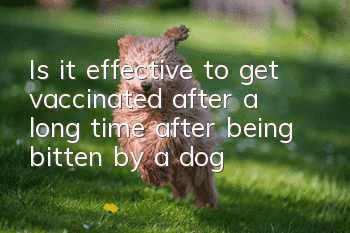Is it effective to get vaccinated after a long time after being bitten by a dog?

Rabies is known by the medical community as a disease that can only be prevented but cannot be treated. The reason is that once rabies occurs, there is 100% death.
More than 95% of rabies cases in my country are caused by bites from rabid dogs, and the rest are caused by bites and scratches from cats or other domestic and wild animals. Rabies virus exists in large amounts in the saliva of rabies. Studies have found that when a person is bitten by a rabies, the rabies virus first multiplies around the wound and invades the peripheral nervous tissue, and then invades the central nervous system along the peripheral nerves at a speed of 8 to 22 mm per day. . After the rabies virus enters the central nervous system, clinical symptoms of rabies gradually appear. The incubation period of rabies varies greatly, ranging from 10 days and a half to several years. The length of the incubation period depends on the body's resistance, the amount of virus entering the body and the virulence of the virus, as well as the bite site, the depth of the wound and other factors.
The clinical manifestations of rabies are very special, starting with itching, pain and numbness around the healing wound. As the disease progresses, patients begin to experience symptoms such as fatigue, loss of appetite, headache, insomnia, and nausea. Then it gradually becomes a state of excitement, a sense of fear, an allergic reaction to stimulation by sound, light, and wind, and a feeling of tension in the throat. It is often stimulated by loud noises, blowing wind, etc., which can trigger restlessness and general convulsions. Hydrophobia is a special symptom of rabies. The patient will experience throat or whole body spasms when hearing the sound of water or seeing water. In the later stages of the disease, patients gradually become quiet, fear disappears, spasms stop, muscles relax, the mandible drops, mouth drools, reflexes disappear, pupils are dilated, and often die due to respiratory and heart failure. There is no cure.
The way to prevent rabies is to vaccinate against rabies. There are two methods: (1) Pre-exposure vaccination, that is, healthy people should be vaccinated against rabies before they are bitten or scratched by rabies. Those who often work in the field, rural postmen who travel from village to house, tourists to epidemic areas, people living in rabies endemic areas, and staff at dog breeding farms are all suitable candidates for vaccination. Three injections of rabies vaccine on days 0, 7 and 21, each injection is 1.0ml, can provide immunity for more than 1 year. (2) Post-exposure vaccination. When bitten or scratched by a rabid dog or other animal, regardless of age or gender, the local wound should be treated immediately. After repeated washing with soapy water, the wound should be disinfected several times with iodine tincture. Then get the rabies vaccine in full and in a timely manner. Generally, the person who was bitten is given one shot of rabies vaccine on the 0th day (the first day, the same day), the 3rd day (the 4th day, and so on), the 7th day, the 14th day, and the 28th day, for a total of 5 shots. The dosage for children is the same. For severe bites (those who are bitten in three places on the head, face, neck, fingers, or multiple parts, or who lick the mucous membrane), in addition to injecting rabies vaccine according to the above method, double the amount of rabies vaccine should be injected on day 0 and day 3, and the amount should be injected on day 0 At the same time as rabies vaccine, use anti-rabies serum (40IU/Kg) or anti-rabies immunoglobulin (20IU/Kg) to infiltrate the bite site and inject intramuscularly. Those who use anti-rabies serum or immune globulin in combination must complete the entire vaccine injection and then addGive 2 to 3 doses of the vaccine. That is, a booster injection of rabies vaccine will be given on the 15th, 75th, or 10th, 20th, and 90th days of the full injection, for a total of 9 or 10 injections of rabies vaccine.
In the past, there was a view that after being bitten by a rabies, the rabies vaccine was not injected in time due to various reasons. After a few months, it became "all right", and there was no need to use rabies vaccine to prevent rabies. this is not right. Because if it is definitely bitten by a rabid dog, according to statistics, about 5% of rabies patients have an incubation period of more than 12 months. Therefore, the World Health Organization recommends that patients who have been bitten by rabies for several months should undergo the above-mentioned treatment and vaccination procedures.
- Can’t you train a Husky? Husky training tips!
- Dog hepatitis symptoms and prevention measures
- What is canine distemper? Symptoms and treatment of canine distemper in dogs!
- Things to note when raising a French bulldog
- How to euthanize a dog
- A must-read for poop scrapers, 14 symptoms of sick pets at home!
- A few pictures to help you easily determine whether your dog or cat’s weight is standard
- How to give injections to dogs? What you need to know about dog vaccinations - The pet next door
- How to supplement calcium for Rottweiler puppies?
- Symptoms of meningitis in dogs



